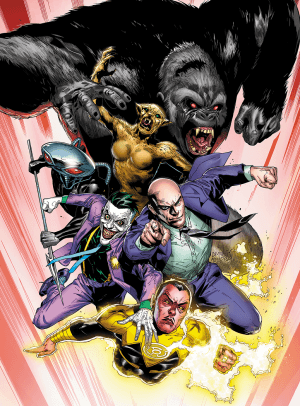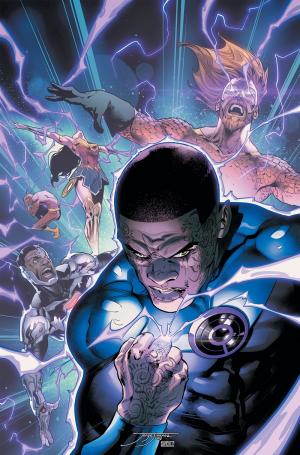How Justice League Changes the Fabric of the DC Universe
We have exclusive details from Scott Snyder on how the new Justice League series expands on the DC Universe in new and unexpected ways.
Scott Snyder is probably DC Comics’ heaviest regular hitter working now. He started with the company at Vertigo, winning an Eisner for American Vampire. Then he hit a home run with “The Black Mirror,” a note-perfect Batman story in the pages of Detective Comics, and that led him to become the anchor of the New 52 era of Batman, crafting a defining run with artist Greg Capullo. Then he got to be the mastermind behind DC’s first post-Rebirth crossover, the absolutely bonkers Dark Nights: Metal, a book that, in addition to being ridiculously fun and very personal, also brought the full DC multiverse and all its crazy timelines back into play.
Now, in the wake of Metal, Snyder is taking over as writer on a new Justice League series. Mr. Snyder talked to us about his approach to breaking his characters down and building them back up and applying it to the League – specifically The Flash and the revelation that there’s another fundamental force that Flashes can tap into: the Still Force.
With the full cosmic scope of the DC Universe now in the picture, it means a slightly new approach is needed to tell Justice League stories. “The goal with Justice League is to have every arc focus on two characters in the League, even though everybody is sort of in every arc,” Snyder tells us. “The goal is to expand everybody’s mythology, show how amazing these characters are, and then show you secrets that you didn’t know about them and about their mythos.”
Each arc in Justice League will be four or five issues, allowing different pairings to take the lead. “In the first arc, we’re really focused on Green Lantern and Flash,” Snyder says. “And one of the things that’s huge about our reveals about Flash and how they connect to Flash War is that the Speed Force has embedded within it other forces that have always balanced and counteracted it in ways that Barry has never completely understood.”
In other words, just as Snyder’s Batman introduced new elements of Gotham’s history to great effect on Bruce Wayne, early on in Justice League we’re going to learn something new about the team members and the DCU as a whole. In the case of Flash, it’s called the Still Force, and, according to Snyder, it will “have a lot of influence on both where [Barry] goes as a character and also his past.”
“The Still Force is an energy in the universe that’s trying to slow everything down entropically, trying to stop everything, trying to bring everything to a standstill,” Snyder explains. “And it has its own characters, it has its own figures that are connected to it who might not even know they are. And it’s a complete enigma to Barry at this point.”

But as its name suggests, the Still Force isn’t something that is exclusive to speedsters. One of the important pieces of Justice League will be the introduction of the Legion of Doom, familiar to longtime fans as the antagonists of the classic Challenge of the Super Friends animated series. And one of that team’s members might be particularly suited to harnessing it. “One of Barry’s greatest villains, Gorilla Grodd, might have a leg up on him when it comes to figuring out how to control this thing,” Snyder hints.
But the Still Force is only one of the new elements that will be introduced to the DC Universe
“The idea, really, is to show that these characters think they know their powers, think they know their mythologies, think they know even sometimes their histories and their missions,” Snyder says. “And then to sort of blow those things up.”
It won’t stop with Flash. Green Lantern mythology is also set to be expanded.

“We revealed the cover, not long ago, that had Jon Stewart seemingly powered by an invisible emotional spectrum, ultraviolet, infrared, those kinds of powers that have been locked away and possibly known about by Sinestro for a long time,” Snyder says. “So similarly, it’s almost like with each pair of characters in each arc, we want you to feel as though you’re learning things about their mythology you never knew existed, just as they are. They’re challenged by bigger forces, bigger enemies, bigger conflicts and bigger mysteries than we’ve ever tried before with these guys. We want everything to feel new and unfamiliar.”
And part of what makes the DC Universe bigger is its infinite realities approach to storytelling. Dark Nights: Metal opened up DC’s multiverse in a way not seen since Grant Morrison’s Multiversity, but with Justice League, another wild, alternate timeline/reality warping DC Universe concept will make its return: Hypertime.
“We have a very big story — not to spoil too much — called the Something of Hypertime,” Snyder says. “I don’t wanna give away what it is, whether it’s like the Death, the Birth, anything like that. But that’s coming both in Flash and in Justice League. This is our opus. This is my DC love letter/opus/soap opera that has started all the way back in Batman, but really ratcheted up to the whole DCU in Metal.”
Hints of this are already being seeded in the weekly Justice League: No Justice miniseries, which Snyder is co-writing with James Tynion IV and Josh Williamson.
“No Justice sets up all the different books and tributaries by which we’re going to be continuing it,” Snyder says. “We’re building out from this so that that story that we’re doing in No Justice right now with the Omega Titans, and all of it’s starting because the Source Wall broke, Amanda Waller tries to hack Brainiac…all of that stuff plays forward. So when you see Hypertime or one of the four energies, for example, that Brainiac references in No Justice…when that starts to go and what happens to it in No Justice happens, that greatly affects Hypertime, the Speed Force, the Still Force, all of that stuff.”
All of this couldn’t be more different than the Gotham-centric mythology Snyder and collaborators built up over five years on Batman. Snyder admits that “Batman will always be my favorite character” but he feels that Justice League is “the heart and soul of the line.”
“Our goal is to be like the DC that you knew and loved and always enjoyed reading about not only is still there, but is invigorated and vibrant and robust and being done in a new way,” Snyder says. “So none of it is looking backwards in nostalgia. All of it is like, ‘Oh, Hypertime’s coming back? Well, it’s coming back in a new way. Martian Manhunter’s back? Well, where has he been?’ That’s a big story. What happened to Hawkman? Where did he go? In Metal, you saw that he was somewhere trying to find out a secret. Well, here you go. Batman might have to go back to Barbatos, so the Dark Multiverse — now I’m spoiling too far ahead.”
“While I think people have done incredible work on it over the years that I’ve been at DC, the thing that I’ve really wanted to bring back is a connectivity and a sort of core-hub feeling that this book lies right at the center of everything you’re reading about in other books,” Snyder says. “So even though the books function independently — you don’t need to read Justice League to know what’s happening in Aquaman, what is happening in Aquaman is reflected in Justice League. Our book is sort of, to me, a spotlight on all the great stuff happening around the DCU.”
It turns out that Snyder has known he was taking over Justice League for over a year and he has a story plan that stretches “all the way through the end of 2019.” And as you can expect, with each arc, new secrets of the DC Universe will be revealed.
“There will be really big points throughout this two-year plan I have on Justice League where the story blows out into other books or gives touch points that these books can react to and build story on if they want,” Snyder says. So get ready for potential revelations about Aquaman and Wonder Woman (the focus of the book’s second arc) or Superman and Martian Manhunter (the focus of the third arc).
“The thing that I felt was missing in some ways from Justice League was the connectivity,” Snyder says. “That feeling that they’re not just seven big characters that exist on the Watchtower and fight aliens and fight the biggest stuff and wrestle with their role with civilians and all that stuff. I always loved the version where it was like, ‘They are the hub and they meet everybody.’ In the first issue of Justice League, you’re gonna see Vixen and Animal Man and Dr. Fate and Swamp Thing and The Atom. I promise you, you will get how big we’re going from page one.”
So it’s no accident that the League is once again calling its most familiar headquarters home: The Hall of Justice.
“The Hall of Justice, to me, is the hub, it is the central core of the Justice League group,” Snyder says. “So every group within Justice League — and also just any superhero at all — has access to this, and some of them even have portals to their team bases within the Hall of Justice. We want you to feel like when you pick you a DC book, Justice League speaks to and is connected to all those things that you’re enjoying, gives you hints and even drivers towards things that will be happening soon, either because of events in Justice League itself or because of some of the great story planned in the books outside of Justice League.”
One thing that can never be questioned, though, is Snyder’s enthusiasm. “This story is going to weave through every Crisis, every historical DC story that we’ve done, to build to something very special,” he promises. “Arc by arc, pair of characters by pair of characters, mythology by mythology, my goal is to have this be my giant DC soap opera opus. I mean, I have no plans after this. If I never made another superhero comic, I want this to be the one I can go out on. This is my dream to get to write this book, and I have such good partners in James Tynion and Josh Williamson, and artistically Jim Cheung and Jorge Jimenez. I have all the tools at my disposal and the partners that inspire me, I feel like, to make something that I hope is the best thing I’ve ever done in superheroes.
“These are the greatest characters in the world and my favorite people that have ever taken them, like Grant Morrison and others, they go out there and they risk falling on their face to do something really game changing and big. That’s my goal.”
Justice League #1 is in stores today.
